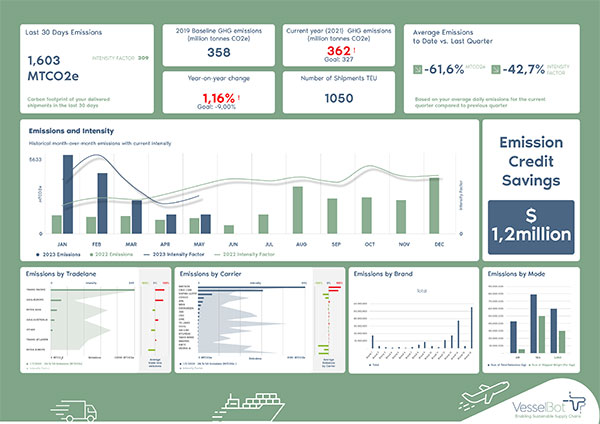The significance of accurate Scope 3 emissions data, why current reporting is falling short, and tools that can drive a sustainable future.
As the staggering environmental consequences of climate change unfold before our eyes, governments and corporations are swiftly working to accurately gauge their Scope 3 emissions, all in a desperate bid to stave off further harm to our precious planet.
Emissions data are not just numbers on a spreadsheet; they are the compass guiding us towards a greener tomorrow. However, as we stand on the precipice of an era marked by unprecedented environmental challenges and regulatory requirements, it’s clear that the current approach to Scope 3 emissions data is not just inadequate; it’s outdated.

As per Carbon Trust, “Scope 3 emissions, also referred to as value chain emissions, often represent the majority of an organization’s total greenhouse gas (GHG) emissions. Scope 3 emissions are the result of activities from assets not owned or controlled by the reporting organization, but that the organization indirectly affects in its value chain.”
California’s state Senate approved a bill that requires large companies to measure and report their carbon footprints including a complex category of indirect emissions linked to their supply chains. As Scope 3 emissions of one organization are Scope 1 and Scope 2 emissions of another organization, its reporting is considered by many organizations as being tricky and difficult to measure.
The winds of change are also blowing in the regulatory landscape. Governments and international bodies are increasingly mandating the reporting of Scope 3 emissions. The IOSCO-IASB, the CSRD, the EU ETS, and SEC regulations are all indicative of a global shift toward greater transparency and accountability in sustainability reporting.
As a result, higher accuracy and primary data are no longer optional but essential. Companies must have access to dependable emissions data to substantiate their reported figures and meet evolving regulatory requirements.
One glaring issue is the inaccuracy of data used for Scope 3 emissions reporting. It’s a well-known fact that these figures can vary significantly, leading to both overestimation and underestimation of a company’s environmental footprint. This inherent uncertainty not only erodes the credibility of sustainability reports but also hampers effective decision-making.
Protocols like the GHG (Greenhouse Gas) Protocol, while groundbreaking in their time, are no longer suitable for today’s dynamic and interconnected world. They rely on average historical data that no longer capture the complexity of modern supply chains and transportation networks. The result? Data that are anything but actionable.
Non-actionable data pose a significant risk to companies. The inability to act upon emissions data leaves them vulnerable to accusations of greenwashing, where sustainability claims do not align with actual practices. Moreover, non-compliance with evolving environmental regulations can result in legal repercussions and reputational damage.
It’s time for a paradigm shift. Companies need data that not only reflect their emissions accurately but also empower them to make informed decisions. Actionable data enable businesses to take concrete steps toward reducing their carbon footprint, leading to cost savings and a more sustainable future.

So, what does actionable data entail?
In this age of sustainability, the efficacy of sustainability reporting largely depends on the various tools, metrics and methods that are employed. Reporting of Scope 3 emissions require precision and clarity failing which there could be vast ramifications to the reporting organization and to the world in general.
The role of advanced technologies can extend to sustainability reporting and the use of advanced technologies like AI (Artificial Intelligence) and ML (Machine Learning) can bridge the gap between outdated protocols and actionable data.
The tools can breakdown complex and complicated data sets and convert them into real-time actionable insights on critical emission factors and supply chain metrics.
Businesses interested in accurately reporting Scope 3 emissions can learn from case studies and best practices of organizations who have created successful Scope 3 reporting mechanisms. Collaboration within similar industries can help in developing standards for such reporting.
In a time when environmental sustainability has become an imperative rather than a trend, the urgency of obtaining precise and actionable Scope 3 emissions data cannot be emphasized enough.
Businesses must urgently allocate resources to adopt technologies and solutions that offer clear and exact insights into their emissions, empowering them to take significant strides toward a more environmentally responsible future. The path to sustainability starts with data that not only narrates a tale but also charts an urgent course of action for transformation.
As we move towards a sustainable future, it is imperative that organizations redefine their sustainability reporting and leverage advanced technologies, collaboration, and training to achieve better results.

Contact:
Website: www.vesselbot.com: Enabling Sustainable Supply Chains | VesselBot
In this episode, I sat down with Beejan Giga, Director | Partner and Caleb Emerson, Senior Results Manager at Carpedia International. We discussed the insights behind their recent Industry Today article, “Thinking Three Moves Ahead” and together we explored how manufacturers can plan more strategically, align with their suppliers, and build the operational discipline needed to support intentional, sustainable growth. It was a conversation packed with practical perspectives on navigating a fast-changing industry landscape.